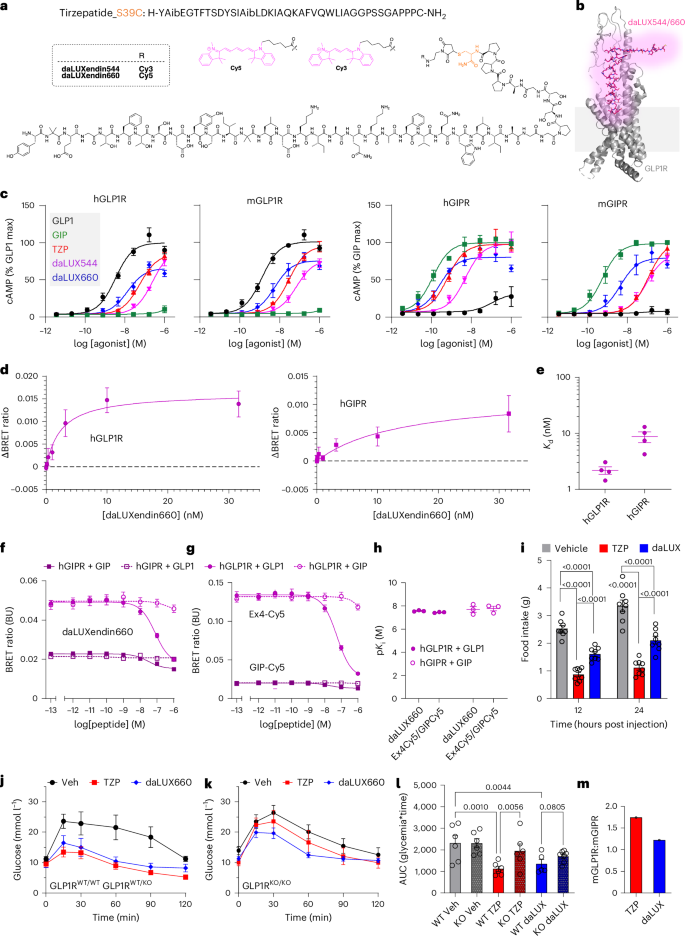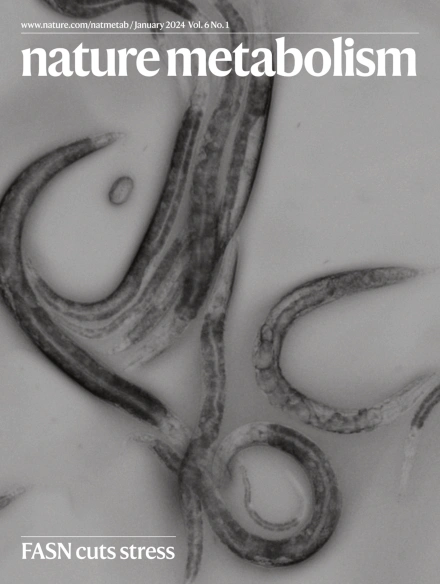Fluorescent GLP1R/GIPR dual agonist probes reveal cell targets in the pancreas and brain
IF 20.8
1区 医学
Q1 ENDOCRINOLOGY & METABOLISM
引用次数: 0
Abstract
Dual agonists targeting glucagon-like peptide-1 receptor (GLP1R) and glucose-dependent insulinotropic polypeptide receptor (GIPR) are breakthrough treatments for patients with type 2 diabetes and obesity. Compared to GLP1R agonists, dual agonists show superior efficacy for glucose lowering and weight reduction. However, delineation of dual agonist cell targets remains challenging. Here, we develop and test daLUXendin and daLUXendin+, non-lipidated and lipidated fluorescent GLP1R/GIPR dual agonist probes, and use them to visualize cellular targets. daLUXendins are potent GLP1R/GIPR dual agonists that advantageously show less functional selectivity for mouse GLP1R over mouse GIPR. daLUXendins label rodent and human pancreatic islet cells, with a signal intensity of β cells > α cells = δ cells. Systemic administration of daLUXendin strongly labels GLP1R+ and GIPR+ neurons in circumventricular organs characterized by an incomplete blood–brain barrier but does not penetrate the brain beyond labelling seen with single (ant)agonists. At the single-molecule level, daLUXendin targets endogenous GLP1R–GIPR nanodomains, which differ in organization and composition from those targeted by a single agonist. daLUXendins reveal dual agonist targets in the pancreas and brain and exclude a role for brain penetration in determining the superior efficacy of dual agonists, shedding new light on different modes of action of dual agonists versus single agonists. A series of fluorescent probes is designed that act as dual agonists on both GLP1 and GIP receptors, and are used to image receptor binding activities in tissues and animals.


荧光GLP1R/GIPR双激动剂探针显示胰腺和脑中的细胞靶标。
针对胰高血糖素样肽-1受体(GLP1R)和葡萄糖依赖性胰岛素性多肽受体(GIPR)的双重激动剂是治疗2型糖尿病和肥胖患者的突破性疗法。与GLP1R激动剂相比,双激动剂在降糖和减肥方面表现出更优越的疗效。然而,描述双重激动剂细胞靶点仍然具有挑战性。在这里,我们开发并测试了daLUXendin和daLUXendin+,非脂化和脂化荧光GLP1R/GIPR双激动剂探针,并使用它们来可视化细胞靶点。daLUXendins是一种有效的GLP1R/GIPR双重激动剂,对小鼠GLP1R的功能选择性比小鼠GIPR低。daLUXendins标记啮齿动物和人胰岛细胞,信号强度为β细胞> α细胞= δ细胞。全身给药daLUXendin强烈标记以血脑屏障不完整为特征的脑室周围器官中的GLP1R+和GIPR+神经元,但不穿透大脑,超出单一(蚂蚁)激动剂所见的标记。在单分子水平上,daLUXendin靶向内源性GLP1R-GIPR纳米结构域,其组织和组成与单一激动剂靶向的结构域不同。daLUXendins揭示了胰腺和脑中的双重激动剂靶点,排除了双激动剂在确定双激动剂优越疗效中的脑渗透作用,为双激动剂与单激动剂的不同作用模式提供了新的思路。
本文章由计算机程序翻译,如有差异,请以英文原文为准。
求助全文
约1分钟内获得全文
求助全文
来源期刊

Nature metabolism
ENDOCRINOLOGY & METABOLISM-
CiteScore
27.50
自引率
2.40%
发文量
170
期刊介绍:
Nature Metabolism is a peer-reviewed scientific journal that covers a broad range of topics in metabolism research. It aims to advance the understanding of metabolic and homeostatic processes at a cellular and physiological level. The journal publishes research from various fields, including fundamental cell biology, basic biomedical and translational research, and integrative physiology. It focuses on how cellular metabolism affects cellular function, the physiology and homeostasis of organs and tissues, and the regulation of organismal energy homeostasis. It also investigates the molecular pathophysiology of metabolic diseases such as diabetes and obesity, as well as their treatment. Nature Metabolism follows the standards of other Nature-branded journals, with a dedicated team of professional editors, rigorous peer-review process, high standards of copy-editing and production, swift publication, and editorial independence. The journal has a high impact factor, has a certain influence in the international area, and is deeply concerned and cited by the majority of scholars.
 求助内容:
求助内容: 应助结果提醒方式:
应助结果提醒方式:


